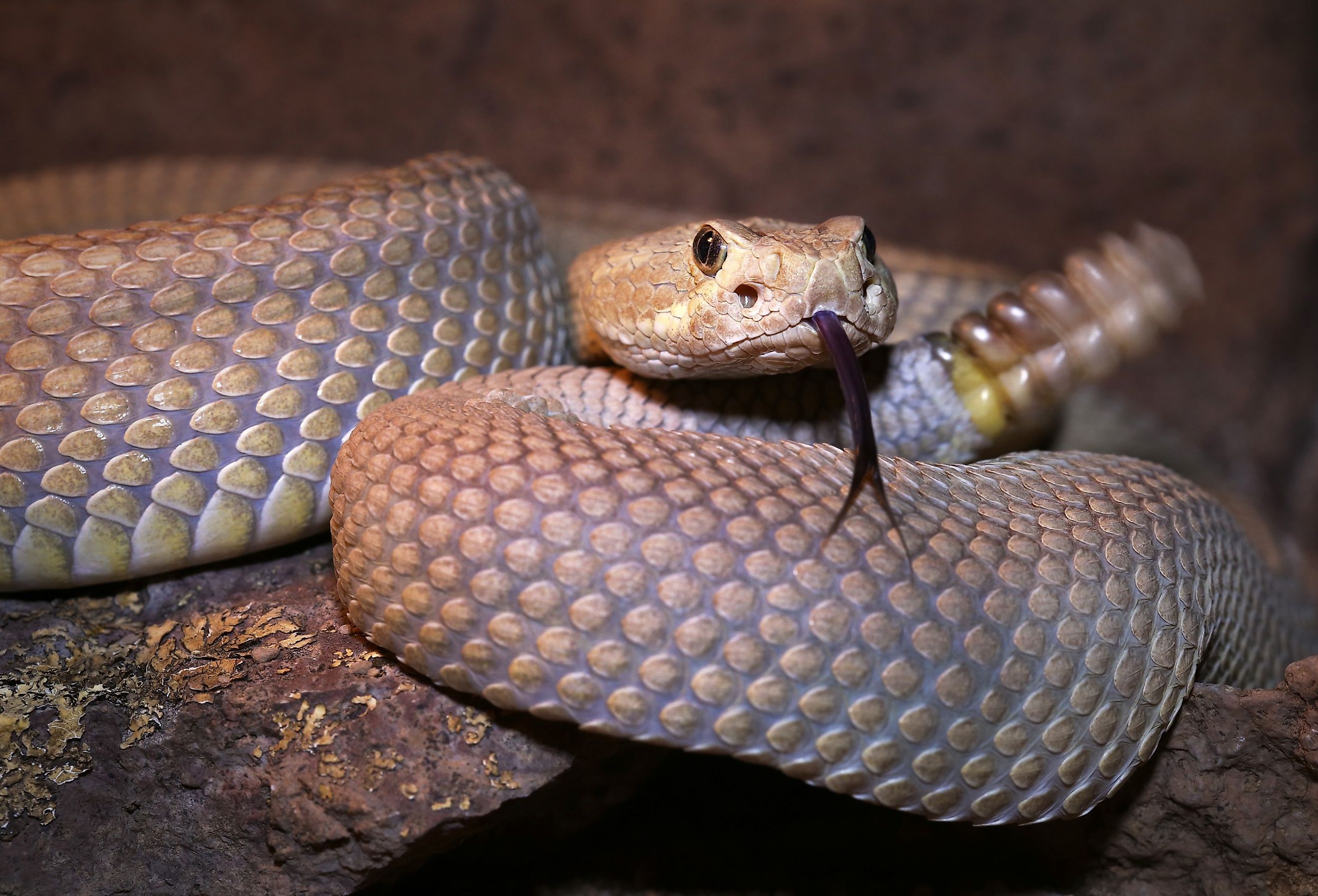
The 12 Deadliest Animals in Nevada
Nevada is the 36th US state, landlocked around Oregon, Idaho, Utah, California, and Arizona. Known as the Silver State, Nevada is the most mountainous and driest state in the US! Plenty of people know Nevada for the lively vibes of Las Vegas, its immaculate state parks, and the mighty Hoover Dam. But between the dramatic mountain ranges and the sandy landscape, the Silver State is thriving with wildlife. A vast collection of animals thrive in Nevada, from the cold-blooded reptilians to the mammals and invertebrates of the state. Desert tortoises, desert bighorn sheep, and the bald eagle may call Nevada home, but this dry state also houses wildlife that is considered dangerous and deadly. From elusive mountain lions to unassuming deer mice, discover the deadliest animals in Nevada.
Mountain Lions
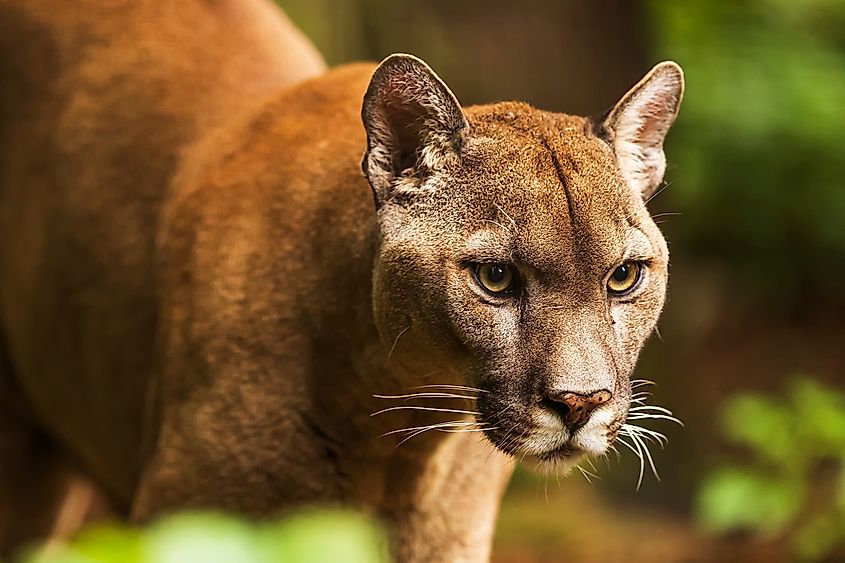
Mountain lions (Puma concolor) are also known as cougars, panthers, pumas, or catamounts. These cats are solitary and adaptable, capable of surviving in various habitats. They will often live in areas where mule deer exist. Their distribution is wide, and they are found in Canada and Chile! In Nevada, a mountain lion’s habitat usually includes environments with pinyon pine, juniper, mountain mahogany, ponderosa pine, and mountain brush. Mountain lions are crepuscular animals and are mostly active during dusk and dawn. Nevada permits mountain lions to be hunted, though trapping them is prohibited. Unfortunately, however, about 24 of these majestic animals are mistakenly killed each year from traps that were set for bobcats.
Mountain lions are elusive and avoid areas of human disturbance. An encounter and risk of a mountain lion attack is rare. Despite their penchant for avoiding humans, humans should not underestimate the might of this potentially deadly animal in Nevada. Reduce the chances of encounters by removing items that can attract deer (or other animals that lions prey on), like bird seeds, pet food, garbage, fallen fruit, woodpiles, or excess shrubs. Children should be supervised while playing outdoors, and pets should be kept indoors at night to avoid mountain lions preying on them. While venturing into mountain lion country, stay alert, do not wear headphones, and avoid outdoor activities during peak mountain lion activity—between dusk and dawn.
Mojave Desert Sidewinder Rattlesnakes
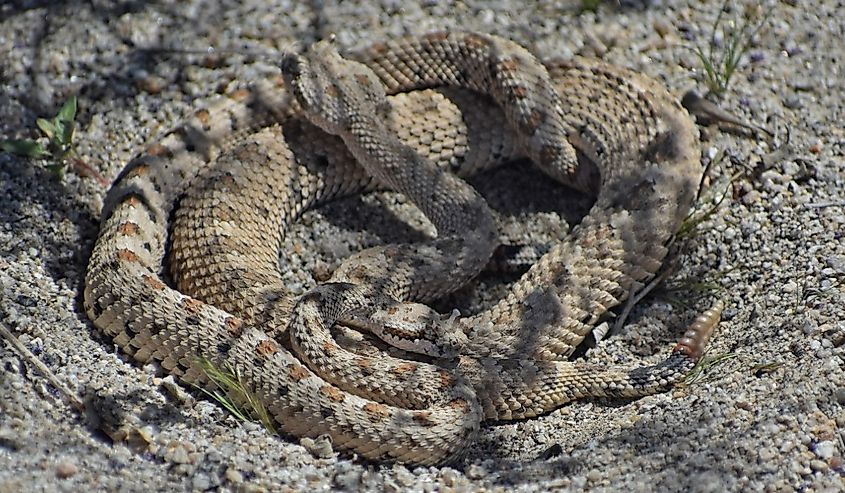
Rattlesnakes are present throughout Nevada, behaving as predators to rodents. Out of 52 snake and lizard species in the state, 12 of them are considered venomous, and six of them are dangerous to humans and pets. The Mojave desert sidewinder rattlesnake (Crotalus cerastes cerastes) is one of the snake species that pose a risk to humans and pets.
The sidewinder is the smallest rattlesnake in Nevada. Sidewinders prefer sandy terrains like the Mojave Desert, specifically around sandy washes and densely vegetated spaces with mammal burrows. These reptilians have short bodies but large fangs for a rattlesnake. They also sport horn-like raised scales above their eyes that act as sun protection for their eyes. A sidewinder’s primary diet is made up of lizards, but also prey on pocket mice, kangaroo rats, small birds, other snakes, and other small mammals. Due to its size, the sidewinder is the least dangerous rattlesnake in Nevada since it has less available venom compared to other rattlesnake species in the state.
Mojave Green Rattlesnakes
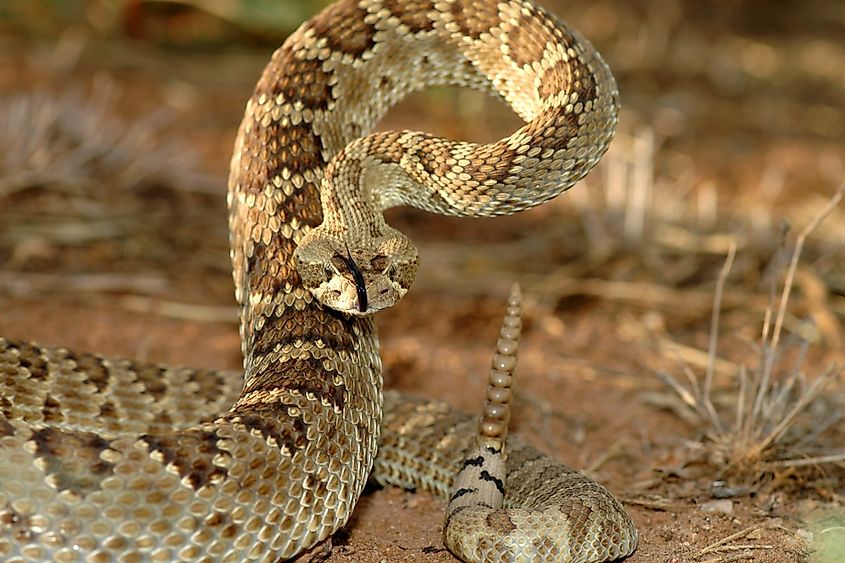
The Mojave Green (Crotalus scutulatus scutulatus) lives throughout the Mojave Desert within valleys, alluvial fans, Creosote-bush scrubland, and the Joshua Tree woodland deserts. Contrary to its name, Mojave green rattlesnakes vary in color, from sporting an olive-green hue to a brown or grey-like body. Their cross-bandings look similar to western diamondback rattlesnakes with the exceptions of a distinct charcoal and light-grey banding seen on its tail and more narrow dark bands than its light band (which is not the case in a western diamondback). The Mojave green harbors venom that is more toxic than other North American rattlesnake species.
Panamint Rattlesnakes
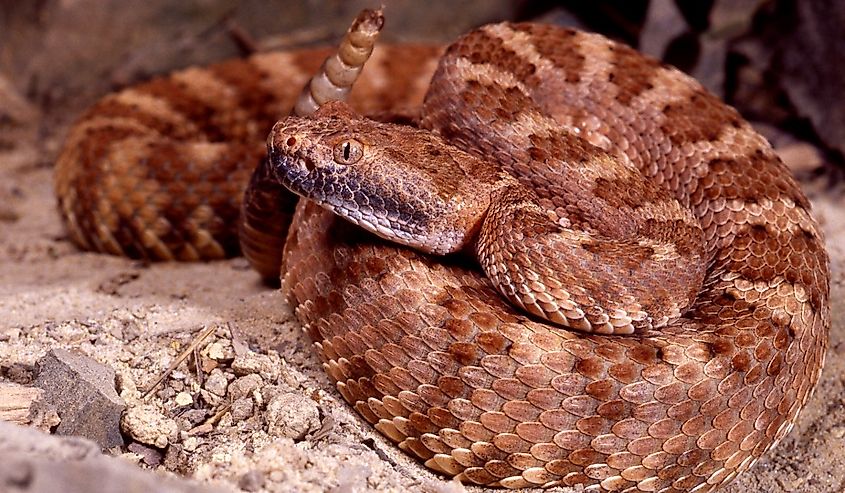
The Panamint rattlesnake (Crotalus stephensi) is medium-sized and was named after the Panamint Mountains. Panamint rattlesnakes are typically found in the mountains and foothills of southwestern Nevada but are also spotted in southern California. They sport dorsal blotches that stand out more than their speckles and exist in various colors of red, pink, and gray. This potentially deadly animal in Nevada is a close relative to the southwestern speckled rattlesnake. Panamint rattlesnakes are nocturnal animals and are most active between the moments before sundown and a few hours after sunset.
Southwestern Speckled Rattlesnakes
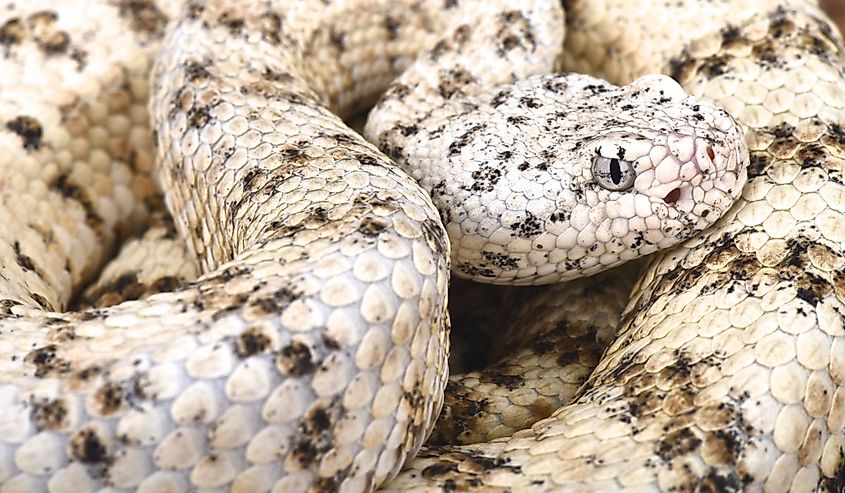
As its name suggests, the southwestern speckled rattlesnake (Crotalus pyrrhus) is a medium-sized snake that sports small speckles across its body. These rattlesnakes are distributed in southeastern Nevada and are found in the canyons and mountains of Clark County. They can also be found in southern California, Utah, and Arizona.
Southwestern speckled rattlesnakes vary in body color, including shades of gray, brown, orange, red, and blue. Their color is closely related to the shade of rocks in their habitat, which helps them blend with their environment as a defense mechanism against predators. Interestingly, these rattlesnakes engage in a behavior called rain harvesting to collect water, in which they use their body to collect rain droplets during events of sparse desert rain. This behavior is a survival mechanism to withstand extreme conditions.
Western Diamondback Rattlesnakes

The western diamondback rattlesnake (Crotalus atrox) is the largest in Nevada, known for its diamond-shaped sports across its lightly colored body. The western diamondback's recognizable characteristic is its extremely bold black and white tail, which is unlike any of Nevada’s other rattlesnake species. These deadly animals in Nevada are found at the extreme southern tip of the state, occupying the Mojave Desert and other habitats like rocky areas or grassy environments.
Western diamondbacks patiently wait for their prey to cross them before consuming them whole! These rattlesnakes can regrow and regenerate their teeth several times a year if they break off during envenomation.
Great Basin Rattlesnakes
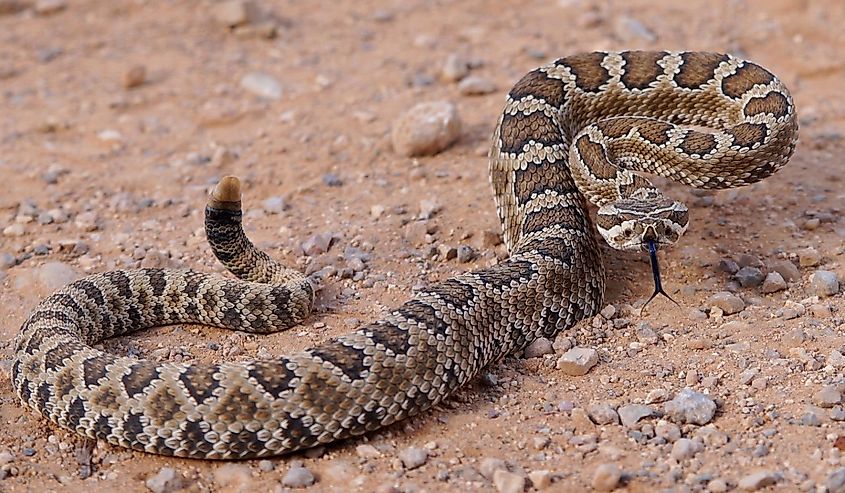
The Great Basin rattlesnake (Crotalus oreganus lutosus) inhabits Northern Nevada and parts of Southern Nevada. They are also present across the western US. These rattlesnakes are often found in grassy, shrubby, and rocky habitats. The great basin rattlesnake is a venomous pit viper with blotched and rounded markings across its back. They will patiently wait for their prey—such as birds, lizards, other snakes, or small mammals—to cross their paths before striking for the kill.
It is uncommon to encounter these venomous reptiles because of their camouflage and evasive nature. A rattle warns provokers when they feel threatened. However, there are moments when rattlesnakes will not rattle before a bite.
If you encounter a rattlesnake in the wild, leave it alone. They will usually flee an area with humans. Many snake bites are the result of people deliberately harassing snakes. While exploring the Nevada outdoors, be mindful of your surroundings and watch where you step, sit, or reach. On hot days, check under the car to ensure snakes are not seeking shelter underneath.
Children should be supervised while playing outdoors and walk pets on a 6-foot leash and keep them from interacting with wildlife and poking their heads in holes or places that have poor visibility. The Nevada Department of Wildlife’s urban wildlife hotline should be contacted if a venomous snake threatens human safety. If you were bitten by a venomous reptile, seek medical attention immediately.
Deer Mice

Also known as the white-footed mouse, the deer mouse (Peromyscus maniculatus) is the most widely distributed mammal in North America. Deer mice have large eyes and ears with a bicolored tail. These mice prefer to live in forests, grasslands, and crops but have also been found within residential spaces. Being nocturnal animals, these mice spend their day resting in nests made of stems, leaves, feathers, or shredded cloth, which are often installed in hollow trees, fence posts, abandoned nests, attics, crawl spaces, or garages. Deer mice are omnivores and enjoy a diet of insects, seeds, nuts, and berries.
As cute as deer mice are, these rodents are natural hosts of hantaviruses, a family of viruses that can cause hantavirus pulmonary syndrome, making them a potentially deadly animal in Nevada. Symptoms of this disease include fatigue, fever, muscle aches, dizziness, headaches, and abdominal problems. Albeit rare, humans can get the infection by direct contact with infected mice, their droppings, rodent nests, bites, or direct inhalation of aerosolized virus particles from mice droppings, urine, or saliva.
To keep this cute critter at bay and outdoors, consider securing houses, cabins, and other indoor dwellings by sealing cracks or large openings. Food that may be easily accessible to rodents like deer mice should be cleaned up properly. When cleaning up after rodents, wear proper protective equipment like a HEPA face mask and rubber gloves, use a general-purpose disinfectant or bleach solution product, and do not use a vacuum or broom to dispose of rodent waste.
Gila Monsters
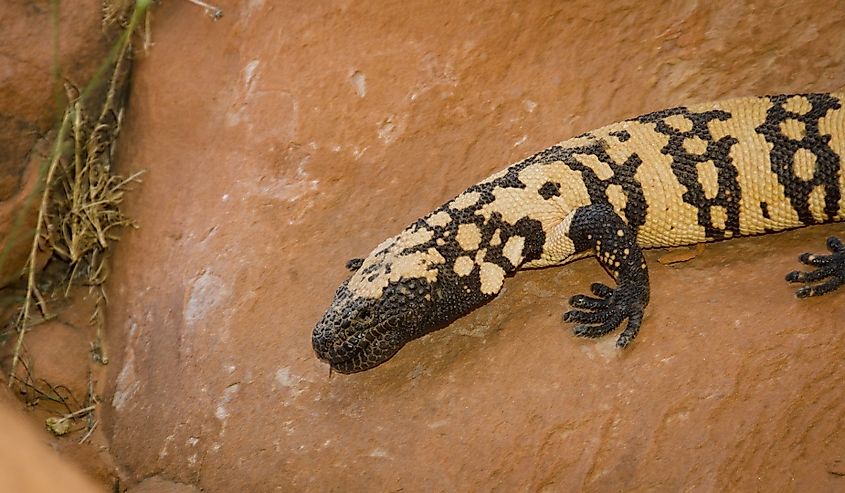
The Gila monster (Heloderma suspectum cinctum) is the largest native lizard species in the US and is a protected species in all US states. Gila monsters are known for their beaded skin with patches of pink, orange, yellow, and black skin. These reptiles live in deserts in Mexico and the southwestern US, yet also thrive in the Mojave Desert. They are often confused with the chuckwalla and western banded gecko, despite both reptiles lacking beaded skin.
Gila monsters are the only venomous lizards in North America. Its venom is secreted by glands found in its sharp teeth on its lower jaw. It is rare for the Gila monster’s venom to be deadly to humans, but its bite is painful. These reptiles will only bite in self-defense in events they feel threatened or cornered. They are also slow-moving animals but can turn their head quickly to bite their provoker.
Never pick up a Gila monster; if left alone, they will leave an area with humans. The Nevada Department of Wildlife can be contacted if a Gila monster poses a public safety threat or does not leave an area with humans.
Bark Scorpions
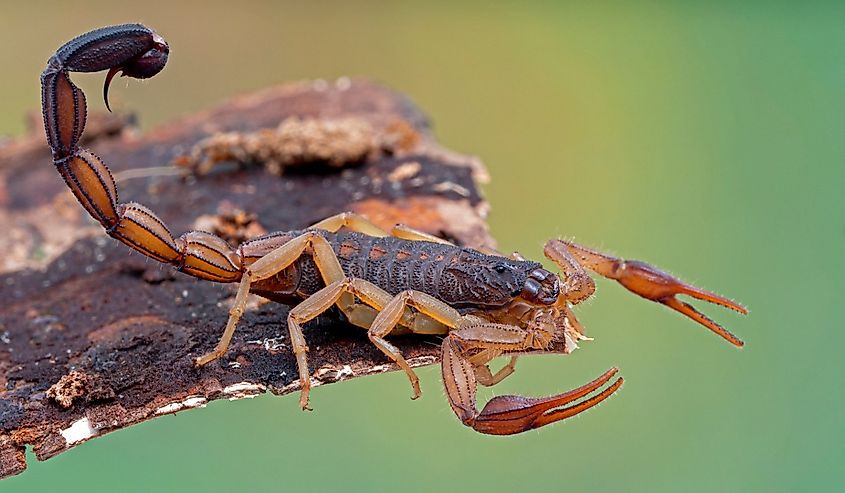
Also known as the Arizona bark scorpions, bark scorpions (Centruroides sculpturatus) are small animals with a maximum length of around 2.5 inches. Though their bodies are tan, they can glow a blue-like hue under UV light. Bark scorpions are found in Southern Nevada and are common in Las Vegas and Clark County. They are also the most common scorpion species in North America and are present in Arizona, the Sonora, Mexico, New Mexico, and Utah. These animals thrive in warm climates and like living in hiding spots in homes and gardens. In addition to having pincers to grab small insects, bark scorpions also have venomous tails.
Bites from bark scorpions are painful, but they are unlikely to be fatal. Still, their strings may harm human health, particularly among children, the elderly, people with poor health, or those who may be allergic to its sting. Like many deadly animals in Nevada, these remarkable animals are best admired undisturbed. Avoid touching or disturbing the scorpion. Since bark scorpions are nocturnal, exercise precautions at night, such as shaking out shoes, clothing, and bedding before use or shining a UV flashlight in dark corners to find any hiding scorpions.
Mosquitos

Many people around the world are familiar with the mosquito, a blood-sucking insect that belongs to the order Diptera (or true flies). These insects are found all around the world (except in Antarctica), with about 170 species found in North America. Mosquitos inject its mouthpart, the proboscis, into its victim’s skin. While drawing blood from its victim, the mosquito will also introduce saliva into the body to prevent blood clotting, which triggers an allergic reaction by the host’s body. This allergic reaction induces localized swelling and causes the individual to be itchy around the bite area.
Do not be fooled by the tiny size of the mosquito! These slender and tiny animals can be considered one of the deadliest animals in Nevada since it is a potential transmitter of mosquito-borne diseases like encephalitis (or sleeping sickness) and malaria. West Nile virus is another mosquito-borne disease, with many cases occurring in the US between summer and fall. Though a majority of people infected with the virus do not feel sick, a few infected individuals may feel symptoms such as a fever, headache, body aches, vomiting, and other symptoms.
To reduce the likelihood of attracting pesky mosquitos, make sure that screen doors and windows are installed properly and in working condition, and remove sources of standing water from your property. While exploring the outdoors in Nevada, wear long pants and long-sleeved shirts during peak mosquito activity at dusk or dawn and use insect repellent with DEET, picaridin, or oil of lemon eucalyptus. If you are venturing outdoors with a canine companion, consider getting them vaccinated against canine heartworms, which can be transmitted to them by mosquito bites.
Black Bears
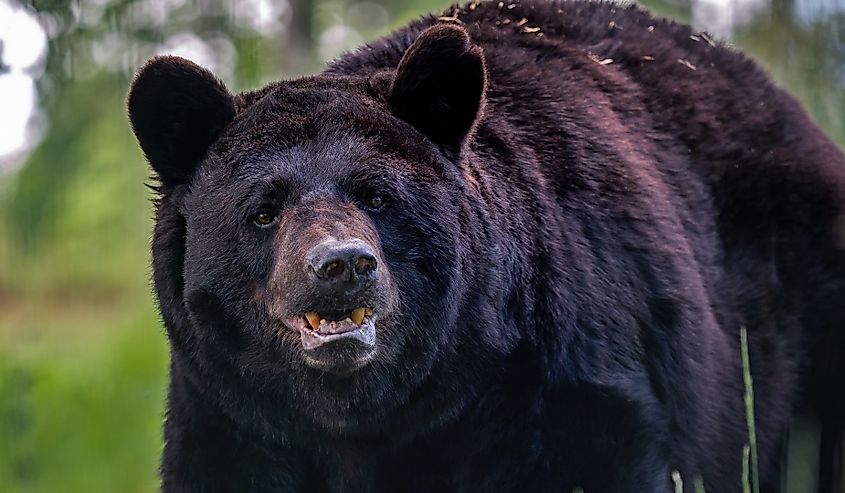
The black bear (Ursus americanus) is the only species of bear found in Nevada. Their name is a misnomer, as these animals come in a variety of colors, like brown, cinnamon, or blonde. As with their distribution, their size can also widely range between about 85 to 900 lbs. In the state, these amazing mammals are found in mountainous settings and the foothills of the Sierra Nevada and Lake Tahoe. Despite being omnivorous animals, a black bear’s diet primarily consists of plant-based foods. These massive animals are capable of consuming between 8,0000 to 20,000 calories daily, especially if it is to pack on pounds for winter hibernation!
Black bears should be treated as unpredictable and potentially dangerous animals in Nevada. It is common for them to detect your presence and flee unless they are conditioned to be around people and food. A majority of conflicts between humans and bears are from humans approaching or feeding them. For the safety of both people and bears, while in Nevada’s bear country, reduce your chance of bear encounters by removing attractants like bird feeders and garbage. Secure waste in bear-resistant containers, clean barbeque grills after use, or consider buying bear spray to protect yourself in the event of close bear encounters. Windows, doors, and vehicles should be locked to avoid entry by bears. While hiking or exploring the outdoors, make your presence known, hike in a group, carefully read all trail signs, and examine any signs of bears like scat, claw marks, or diggings.
Aside from the bright lights of Las Vegas and the amazing power of the Hoover Dam, wildlife is another incredible site in the Silver State. From the rugged mountain ranges to the dry sands, Nevada houses a vibrant range of incredible flora and fauna. While some of Nevada’s wildlife remains relatively harmless, the state is home to a collection of animals that are considered dangerous. From deer mice to mountain lions, there is always a chance that people may encounter a deadly animal in Nevada. Luckily, many of these animals remain elusive and prefer to get away from humans than confront them.











